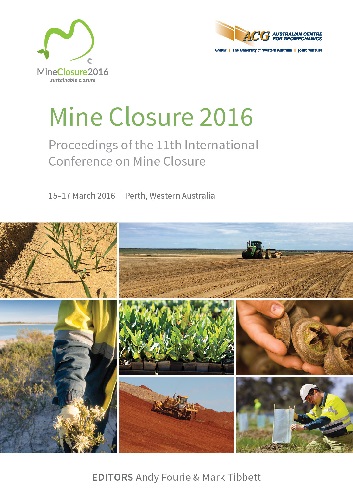Managing the waste rock storage design — can we build a waste rock dump that works?

|
Authors: Barritt, R; Scott, P; Taylor, I |
DOI https://doi.org/10.36487/ACG_rep/1608_07_Barritt
Cite As:
Barritt, R, Scott, P & Taylor, I 2016, 'Managing the waste rock storage design — can we build a waste rock dump that works?', in AB Fourie & M Tibbett (eds), Mine Closure 2016: Proceedings of the 11th International Conference on Mine Closure, Australian Centre for Geomechanics, Perth, pp. 131-140, https://doi.org/10.36487/ACG_rep/1608_07_Barritt
Abstract:
For a waste rock dump to be managed both during operations and at closure, a thorough understanding of the composition of the waste is an important requirement. A comprehensive block model should be prepared, with an appropriate materials management and placement plan developed in conjunction with the mining schedule. However, a waste rock dump’s success is hinged on such compositional elements being regularly updated through ongoing materials characterisation over the life-of-mine. Failure to undertake this may potentially result in inappropriate material placement and classification for environmental purposes, and unnecessary costs to the mine and surrounding environment. A revised cover system and landform design was undertaken for a base metal mine in northern Australia following reclassification of its waste. The original permitted landform design comprised an extensive protective cover system of non-acid forming waste rock (88% of overall waste), encapsulating the small potentially acid forming waste volume (12% of overall waste). Additional geochemical studies indicated that these ratios were incorrect and as such, the total volume of clean non-acid forming waste available for the facility was further decreased to a fraction of the initial value. A cover system incorporating both the barrier and moisture ‘store-and-release’ concepts was proposed to limit net percolation into the reactive potentially acid forming waste. In addition, a landform design and extensive surface water management plan was prepared to manage both the high intensity wet season rainfall received at site and the naturally erosive materials available for landform construction. This paper presents the issues encountered during the design stage, which included: a tropical climate; geochemically reactive waste materials; and a surface water management system design, which was to be maintenance free and similar to natural systems in the long term.
Keywords: mine closure, waste rock dump, rehabilitation, landform
References:
Ayres, B, Dobchuk, B, Christensen, D, O’Kane, M & Fawcett, M 2006, ‘Incorporation of natural slope features into the design of final landforms for waste rock stockpiles’, in Proceedings of 7th International Conference on Acid Rock Drainage, pp. 59–75.
Barritt, R & Scott, P 2015, ‘Cover System Performance Monitoring for Tailings – Are We Doing It Correctly?’, Tailings and Mine Waste, Management for the 21st Century, Sydney.
Beamish, BB, Blazak, DG, Hogarth, LCS & Jabouri, I 2005, ‘R70 Relationships and Their Interpretation at a Mine Site’, in N Aziz (ed.), Coal 2005: Coal Operators' Conference, University of Wollongong & the Australasian Institute of Mining and Metallurgy, pp. 183–186.
Flanagan, DC & Livingston, SJ 1995, Water Erosion Prediction Project (WEPP) Version 95.7: User summary, NSERL Report No. 11. West Lafayette, Ind.: USDA‐ARS National Soil Erosion Research Laboratory.
Hancock, GR, Willgoose, GR, Evans, KG, Moliere, DR & Saynor, MJ 2000, ‘Medium term erosion simulation of an abandoned mine site using the SIBERIA landscape evolution model’, Australian Journal of Soil Research, vol. 38, pp. 249–263.
Hancock, GR, Crawter, D, Fityus, SG, Chandler, J & Wells, T 2008, ‘The measurement and modelling of rill erosion at angle of repose slopes in mine spoil’, Earth Surface Processes and Landforms, vol. 33, pp. 1006–1020.
Jasper, DA, Braimbridge, MF, Lacy, HWB & Russell, M 2006, ‘Integrating waste characterization into landform design for low-risk and low-cost mine closure’, in A Fourie & M Tibbett (eds), Proceedings of the First International Seminar on Mine Closure, Perth.
Mbonimpa, M, Aubertin, M, Aachib, M & Bussière, B 2003, ‘Diffusion and Consumption of Oxygen in Unsaturated Cover Materials’, Canadian Geotechnical Journal, vol. 40, No. 5, pp. 916–932.
Nicholson, RV, Gillham, RW, Cherry, JA & Reardon, EJ 1989, ‘Reduction of Acid Generation in Mine Tailings Through the Use of Moisture-Retaining Cover Layers as Oxygen Barriers’, Canadian Geotechnical Journal, vol. 26. pp. 1–8.
Willgoose, GR, Bras, RL & Rodriguez-Iturbe, I 1991a, ‘A physically based coupled network growth and hillslope evolution model: 1 Theory’, Water Resources Research, 27(7), pp. 1671–1684.
Willgoose, GR, Bras, RL & Rodriguez-Iturbe, I 1991b, ‘A physically based coupled network growth and hillslope evolution model: 2 Applications’, Water Resources Research, 27(7), pp. 1685–1696.
Willgoose, GR, Bras, RL & Rodriguez-Iturbe, I 1991c, ‘A physical explanation of an observed link area-slope relationship’, Water Resources Research, 27.
© Copyright 2026, Australian Centre for Geomechanics (ACG), The University of Western Australia. All rights reserved.
View copyright/legal information
Please direct any queries or error reports to repository-acg@uwa.edu.au
View copyright/legal information
Please direct any queries or error reports to repository-acg@uwa.edu.au